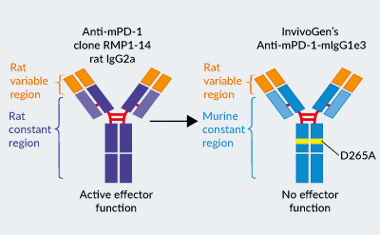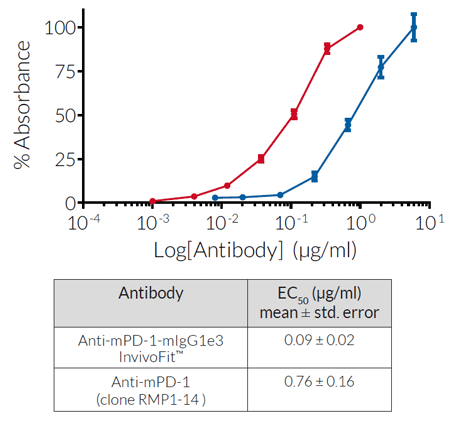Recombinant anti-mouse PD-1 antibody - Clone RMP1-14 (D265A)
| Product | Unit size | Cat. code | Docs. | Qty. | Price | |
|---|---|---|---|---|---|---|
|
Anti-mPD-1-mIgG1e3 InvivoFit™ Recombinant mAb against mouse PD-1 (clone RMP1-14), D265A effectorless. For in vivo use |
Show product |
1 mg 10 mg 50 mg 100 mg |
mpd1-mab15-1
|

InvivoGen’s engineered
Anti-mPD-1-mIgG1e3 InvivoFit™ antibody
Recombinant murinized PD-1 antibody for in vivo use
Anti-mPD-1-mIgG1e3 InvivoFit™ is a recombinant murinized anti-mouse monoclonal antibody (mAb) featuring the variable region of the previously described anti-mPD-1 RMP1-14 mAb [1, 2]. The original RMP1-14 hybridoma was obtained by immunizing rats with cells expressing murine programmed cell death 1 (mPD-1; also known as CD279). The use of xenogeneic sequences (i.e. rat origin) for mAbs renders them immunogenic upon injection in mice [3]. Moreover, special attention should be paid to mAbs targeting the PD-1/PD-L1 axis, as repeated injections of xenogeneic anti-PD-1 or anti-PD-L1 in tumor-bearing mice were shown to induce fatal hypersensitivity reactions [4]. To overcome this issue, Anti-mPD-1-mIgG1e3 InvivoFit™ was generated by recombinant DNA technology so that it is ~65% murine. It contains the constant region of mouse IgG1 with a D265A point mutation (replacement of aspartic acid by alanine at position 265) resulting in the complete loss of unwanted Fc-associated effector functions [2, 5].
Anti-mPD-1-mIgG1e3 is provided in an InvivoFit™ grade, a high-quality standard specifically adapted to in vivo studies.
Key features of Anti-mPD-1-mIgG1e3 InvivoFit™
- Derives from the RMP1-14 clone, rat IgG2a,κ
- Features mouse IgG1e3 isotype (constant region)
- mIgG1e3 (IgG1 with a D265A point mutation) is effectorless
- Blocks the murine PD-1 receptor without causing T cell depletion
- Filter-sterilized (0.2 µm), endotoxin level < 1 EU/mg
- Specifically designed for in vivo studies in mice
- Low aggregation < 5%
- Produced in animal-free facilities and defined media
Anti-mPD-1-mIgG1e3 InvivoFit™ is produced in Chinese hamster ovary (CHO) cells, purified by affinity chromatography with protein A, and its binding is validated by flow cytometry and ELISA.
This antibody is also available in bulk quantity, please contact us
References:
1. Ribas A. & Wolchock J.D., 2018. Cancer immunotherapy using checkpoint blockade. Science. 359:1350-55.
2. Yamazaki T. et al.,2005. Blockade of B7-H1 on macrophages suppresses CD4+ T cell proliferation by augmenting IFN-gamma-induced nitric oxide production. J Immunol. 175(3):1586-92.
3. Brüggemann M. et al., 1989. The immunogenicity of chimeric antibodies. J. Exp. Med. 170:2153-2157.
4. Mall C. et al., 2016. Repeated PD-1/PD-L1 monoclonal antibody administration induces fatal xenogeneic hypersensitivity reactions in a murine model of breast cancer. Oncoimmunology. 5(2):e1075114.
5. Baudino L. et al., 2008. Crucial role of aspartic acid at position 265 in the CH2 domain for murine IgG2a and IgG2b Fc-associated effector functions. J. Immunol. 181(9):6664-9.
Specifications
Specificity: Targets cells expressing murine PD-1
Formulation: Lyophilized from 0.2 μm filtered solution in 150 mM sodium chloride, 20 mM sodium phosphate buffer with 5% saccharose
Clonality: Monoclonal antibody
Isotype: Murine IgG1e3 (D265A mutation; no effector function), kappa
Control: mIgG1e3 InvivoFit™ isotype control
Source: CHO cells
Purity: Purified by affinity chromatography with protein A
Tested applications: Flow cytometry and ELISA
Quality control:
- Binding confirmed by flow cytometry
- The complete sequence of this antibody has been verified
- < 5% aggregates (confirmed by size exclusion chromatography)
- Endotoxin level <1 EU/mg (determined by the LAL assay)
Contents
Anti-mPD-1-mIgG1e3 InvivoFit™ is filter-sterilized (0.2 µm), endotoxin-free, azide-free, and lyophilized.
This product is available in four pack sizes:
- mpd1-mab15-1: 1 mg
- mpd1-mab15-10: 10 mg
- mpd1-mab15-50: 50 mg (5 x 10 mg)
- mpd1-mab15-100: 100 mg (10 x 10 mg)
![]() The product is shipped at room temperature.
The product is shipped at room temperature.
![]() Store lyophilized antibody at -20 °C.
Store lyophilized antibody at -20 °C.
![]() Lyophilized product is stable for at least 1 year
Lyophilized product is stable for at least 1 year
![]() Avoid repeated freeze-thaw cycles.
Avoid repeated freeze-thaw cycles.
InvivoFit™
InvivoFit™ is a high-quality standard specifically adapted for in vivo studies. InvivoFit™ products are filter-sterilized (0.2 µm) and filled under strict aseptic conditions in a clean room. The level of bacterial contaminants (endotoxins and lipoproteins) in each lot is verified using a LAL assay and a TLR2 and TLR4 reporter assay.
Back to the topDetails
Programmed cell death 1 (PD-1; also known as CD279) is a type I transmembrane protein expressed at the cell surface of activated and exhausted conventional T cells. PD-1 is an inhibitory immune checkpoint that prevents T-cell overstimulation and host damage.
PD-1 interaction with its ligands PD-L1 (programmed cell death ligand 1) or PD-L2 induces inhibition of T-cell receptor signaling. Blockade of PD-1 with mAbs has allowed unprecedented remissions in patients with metastatic melanoma or non-small cell lung cancer.






